Sarah Albee's Blog, page 19
August 4, 2014
Book Signing Event
Friday night I attended the annual summer book signing fundraiser, given by the Hotchkiss Library of Sharon, CT. It was a delightful evening, with a mix of authors who write for kids and for adults. I had the good luck to get seated at a table next to Jeff Cohen.
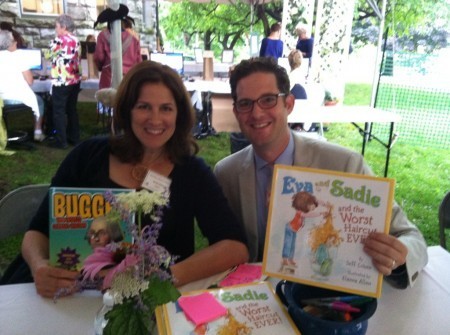 Jeff is a reporter at NPR. You’ve probably heard him on the radio—he often covers national stories–but you may also know him because of an interview he did with his own little daughters a few years ago, after five-year-old Sadie cut three-year-old Eva’s hair. That interview went viral. If you have three minutes, do click and listen. It’s utterly adorable.
Jeff is a reporter at NPR. You’ve probably heard him on the radio—he often covers national stories–but you may also know him because of an interview he did with his own little daughters a few years ago, after five-year-old Sadie cut three-year-old Eva’s hair. That interview went viral. If you have three minutes, do click and listen. It’s utterly adorable.
Now he has an equally adorable picture book about that haircut incident, out with Harper Collins, and a second one on the way.  I also had a chance to catch up with my fellow kid-lit friend, Elise Broach:
I also had a chance to catch up with my fellow kid-lit friend, Elise Broach:

She was signing copies of her latest book, The Miniature World of Marvin James. It’s a Junior Library Guild selection: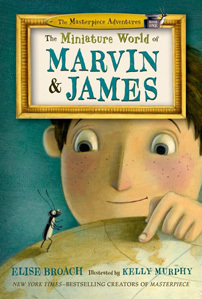 And in a stellar example of Burying the Lead: the highlight of my evening was when stopped by my table to buy a copy of Bugged. Sadly, I was all sold out, but I stumbled out from behind my table to have my picture taken with her (thanks, Jeff!), and she was lovely and gracious, despite the fact that I think I was blathering away semi-incoherently about heaven knows what. Here’s a picture:
And in a stellar example of Burying the Lead: the highlight of my evening was when stopped by my table to buy a copy of Bugged. Sadly, I was all sold out, but I stumbled out from behind my table to have my picture taken with her (thanks, Jeff!), and she was lovely and gracious, despite the fact that I think I was blathering away semi-incoherently about heaven knows what. Here’s a picture:

The post Book Signing Event appeared first on Sarah Albee.
July 31, 2014
Guest Post!
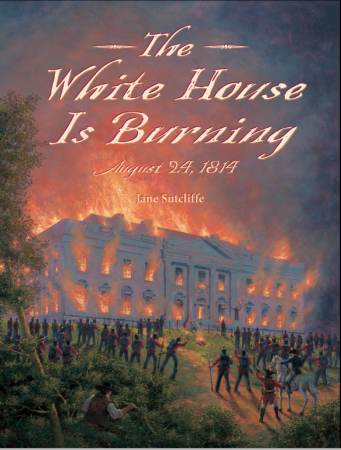 Today on the blog, please welcome my special guest: kidlit writer-friend, Jane Sutcliffe. Jane and I met through the New England chapter of SCBWI, and she is the author of over two dozen nonfiction books for kids, including the fantastic, recent picture book Stone Giant: Michelangelo’s David and How He Came to Be (Charlesbridge). Her new book, The White House is Burning August 24, 1814, is slated for publication next week (August 5, 2014). Jane lives on a farm in Tolland, Connecticut, with her husband, two sons, three goats, and “one very spoiled dog named Willy.”
Today on the blog, please welcome my special guest: kidlit writer-friend, Jane Sutcliffe. Jane and I met through the New England chapter of SCBWI, and she is the author of over two dozen nonfiction books for kids, including the fantastic, recent picture book Stone Giant: Michelangelo’s David and How He Came to Be (Charlesbridge). Her new book, The White House is Burning August 24, 1814, is slated for publication next week (August 5, 2014). Jane lives on a farm in Tolland, Connecticut, with her husband, two sons, three goats, and “one very spoiled dog named Willy.”
Here’s the trailer for the book.
So without further ado—here’s Jane!

Jane Sutcliffe
Paying Attention to the Voices
As a writer of nonfiction, especially history, I often tell people that my job is to listen to voices.
Yeah, I should probably explain that.
I’ve written a fair number of biographies, so I tend to see history from a very personal viewpoint. History for me is like a chorus, each voice telling its own unique story. You’ve got your loud bass voices, the ones belonging to the big names of history. And then there are the smaller, fainter ones. They have their own story to tell.
Those are the voices that fascinated me when I was researching my middle grade book, The White House is Burning: August 24, 1814. They’re the voices of slaves, clerks, and teenage soldiers. They’re the voices of people who were there. They watched the unthinkable happen: enemy troops invading Washington, burning the Capitol and the White House. They watched, up close and in person, as flames lit up the sky brighter even than the moon. I can only imagine what that night must have been like. How could I not listen to their stories?
There was the woman who wrote, “Few thought of going to bed—they spent the night in gazing on the fires.”
A little girl in Baltimore, forty-five miles away, saw the flames and marveled that, “I thought the world must be on fire—such a flame I have never seen since”
I listened to the anguish in the voice of the clerk who could not tear himself from the sight of the city in flames. “So awful,” he called the scene.
I listened to the teenage tourist known only as Miss Brown, who described in horror “the horizon illuminated by the burning Capitol.”
These are real people who experienced that night with real noses pressed against real windows. And they have a story to tell. Listen!
The post Guest Post! appeared first on Sarah Albee.
July 27, 2014
France, Part Trois
It’s Sunday and we’re at the airport, heading home. It’s been an amazing trip.
We left Lyon for Normandy on Wednesday. On the way, we stopped overnight in the Loire region and visited Chenonceaux, a Renaissance chateau that belonged to Catherine de Medici. Actually, it wasn’t hers originally. Catherine’s husband, Henri II, presented it to his mistress, Diane de Poitiers, which rankled Catherine to no end. After he was killed in a freakish jousting accident, Catherine wasted little time bunging Diane out of Chenonceaux. Catherine told Diane she would swap it for a different chateau, named Chaumont, but when Diane entered Chaumont, she found Catherine had had it redecorated with Satanical pentagrams as part of the motif, and Diane was so freaked out, she never returned to it.
Actually, it wasn’t hers originally. Catherine’s husband, Henri II, presented it to his mistress, Diane de Poitiers, which rankled Catherine to no end. After he was killed in a freakish jousting accident, Catherine wasted little time bunging Diane out of Chenonceaux. Catherine told Diane she would swap it for a different chateau, named Chaumont, but when Diane entered Chaumont, she found Catherine had had it redecorated with Satanical pentagrams as part of the motif, and Diane was so freaked out, she never returned to it.
On Thursday we visited the magnificent 12th century Abbey of Fontevraud, where Eleanor of Aquitaine is entombed. Here she is, next to her husband, Henri Plantagenet: Their son, Richard the Lionhearted, is also entombed there, except that this is just one of three burial sites for him. His body was divided up and buried in three different places: his heart was sent to one place and his brain and guts to another.
Their son, Richard the Lionhearted, is also entombed there, except that this is just one of three burial sites for him. His body was divided up and buried in three different places: his heart was sent to one place and his brain and guts to another.
At Bayeux, we visited the famous tapestry. It’s actually not a tapestry (which is by definition woven). It’s an embroidered cloth, magnificent to see in real life. Nine centuries old and 70 meters long, it depicts the events surrounding the Norman conquest of England and the Battle of Hastings, in 1066. At that battle, William, Duke of Normandy, aka William the Bastard (long story) defeated Harold, King of England, and William became known as William the Conqueror. And French became the official language in England for the next three hundred years.

Naughty panel 15
You can see the whole panel here, but I made a beeline for panel 15, because I’ve always been curious about the two mysterious naked guys and was excited to see them in, er, the flesh. Medieval scholars have argued endlessly about this scene. Why is there a naked guy smoothing wood with a sharp, dangerously situated blade? And who is the woman in the main panel, getting slapped by the guy in the cape? And why is there another naked guy in the margin art, just below her? She’s one of only two women in the entire tapestry, and the embroidered caption says: Ubi unus clericus et Ælfgyva, which translates roughly as: Hey, look. It’s a clerk and Ællfgyva. According to the audio guide, Ællfgyva was Harold’s daughter and it’s Harold who is smacking her, because she got herself engaged to William. Or maybe it’s the other way around and she’s getting slapped by William for getting engaged to Harold. Some scholars think the second naked guy may just be a naughty joke thrown in by one of the embroiderers, or he may be her lover hiding under the floorboards, or the first naked guy may symbolize Harold in a precarious predicament and the second one is Harold boasting and acting—literally I suppose—too big for his britches, before he proceeds to get trounced by William later in the tapestry. If you have another theory, please let us know in the comment section.
On Friday we spent a somber day driving around Normandy, viewing the D-Day battle sites and cemeteries (both American and German) with our amazingly knowledgeable and lovely guide, Claire. Here she is with Jon: And here’s Omaha beach, one of the D-day landing sites, which is spectacularly beautiful, and haunting.
And here’s Omaha beach, one of the D-day landing sites, which is spectacularly beautiful, and haunting. I was surprised to see that it was open to the beach-going public, and that there were some people swimming there. But Claire said that WWII veterans she has toured have told her they’re glad that French people use the beaches recreationally, as it reinforces why they fought that day.
I was surprised to see that it was open to the beach-going public, and that there were some people swimming there. But Claire said that WWII veterans she has toured have told her they’re glad that French people use the beaches recreationally, as it reinforces why they fought that day.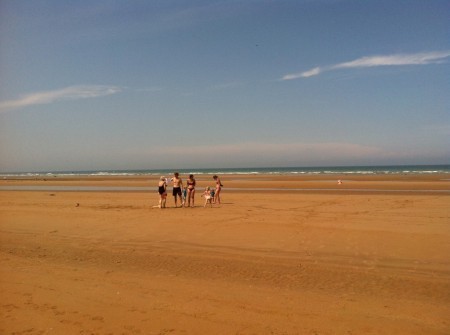
The post France, Part Trois appeared first on Sarah Albee.
July 23, 2014
France, Part Deux
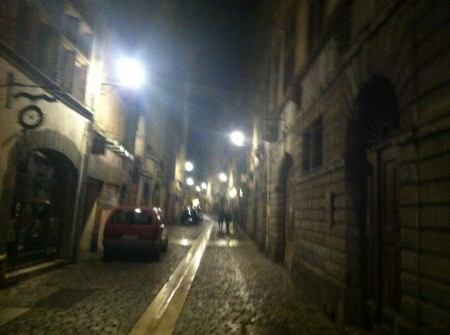 Bonjour again, this time from Lyon, France. We’re staying in an incredible sixteenth century building on a very narrow cobbled street in the old part of the city. Here’s the street–just out of the frame, on the left, would be the heavy oak door to our “hotel,” although it’s really more of a residential apartment, on the sixth floor. It’s awesome. And it has wifi. (Ah “l’ironie!”)
Bonjour again, this time from Lyon, France. We’re staying in an incredible sixteenth century building on a very narrow cobbled street in the old part of the city. Here’s the street–just out of the frame, on the left, would be the heavy oak door to our “hotel,” although it’s really more of a residential apartment, on the sixth floor. It’s awesome. And it has wifi. (Ah “l’ironie!”)
Can you see that there are a few street signs overhanging the narrow street? Maybe you can’t, but trust me—there’s a long wooden baguette signaling a bakery, and a big pair of scissors announcing a barbershop. A few centuries ago, such signs would have been on most streets, because house numbering didn’t start until the nineteenth century. There might have been an enormous tooth announcing the location of a tooth drawer, or a huge cow indicating a butcher. Barber surgeons usually just set a couple of buckets of congealed blood on either side of their doorway, to indicate their services as blood drawers.
We’ve had an action-packed couple of days. Our last day in Paris, we visited the catacombs (thanks to the recommendation of my friend, Kate Messner). They’re a huge bone repository (ossuary) and were created in the galleries of the former quarries whose stone was used to build the major sites of Paris–including the Louvre and Notre Dame. For decades, out of concern for public health (and because so many cemeteries were so overcrowded, bones kept resurfacing during heavy rains), Parisian officials had bones dug up and moved down to the catacombs. You can’t believe how many there are.
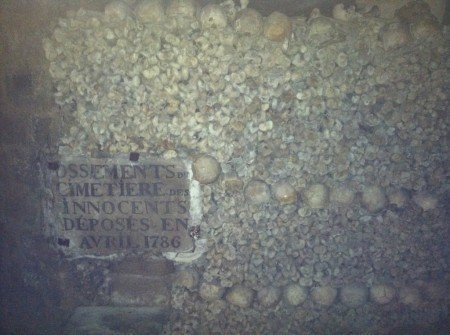 According to the website, the remains of six million Parisians, including many victims of the French Revolution, are there.
According to the website, the remains of six million Parisians, including many victims of the French Revolution, are there.
When we got to Lyon we visited two museums devoted to the silk-making trade, of which Lyon is justly famous, and the museum of decorative arts, which is situated in a magnificent seventeenth-century villa that once belonged to a wealthy Lyonaise family. They had two sedan chairs, and I got to look right inside this one: 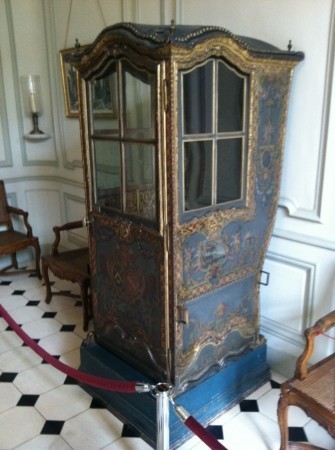 I couldn’t get a good picture, but it was lushly upholstered, with chair arms and everything. And I helpfully explained to a confused American couple that this is known as a pole screen:
I couldn’t get a good picture, but it was lushly upholstered, with chair arms and everything. And I helpfully explained to a confused American couple that this is known as a pole screen: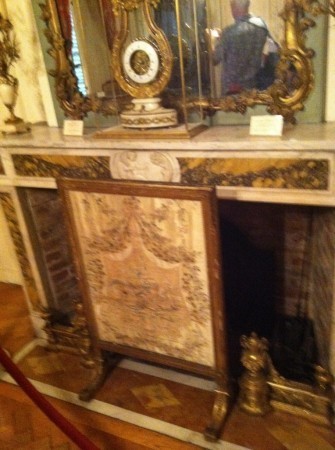 As I have blogged about before, fireplaces were pretty inefficient—blazing hot close up, but inadequate for warming much of a room even a few feet away. So people used pole screens to shield their face from the heat of the fire and to keep their waxy makeup from melting, or their patches from sliding off.
As I have blogged about before, fireplaces were pretty inefficient—blazing hot close up, but inadequate for warming much of a room even a few feet away. So people used pole screens to shield their face from the heat of the fire and to keep their waxy makeup from melting, or their patches from sliding off.
Sadly, the furnished rooms of the mansion had not a single pot de chambre. I know because I asked several of the museum docents.
We also visited the ruins of two Roman amphitheaters. Lyon was an important Roman city in Gaul, founded back in 43 BC. They called it Lugdunum. The larger amphitheater could seat over 10,000 people. Here’s Jon, standing in front of what appear to be the Sky Boxes: And finally, because my basketball-player husband deemed the walking we’d done not quite enough for one day (12.24 miles as clocked by my Fitbit), he decided to “aller faire du jogging.” Actually, he ran up an ancient staircase that happened to be a few feet down the street from our hotel. So as his workout, il a monter les escaliers en courant about nineteen times. Here’s proof:
And finally, because my basketball-player husband deemed the walking we’d done not quite enough for one day (12.24 miles as clocked by my Fitbit), he decided to “aller faire du jogging.” Actually, he ran up an ancient staircase that happened to be a few feet down the street from our hotel. So as his workout, il a monter les escaliers en courant about nineteen times. Here’s proof:
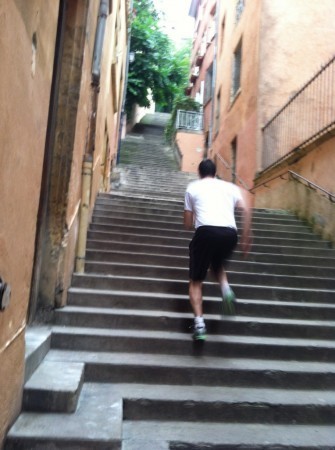
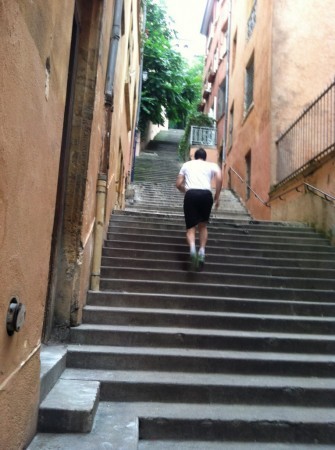
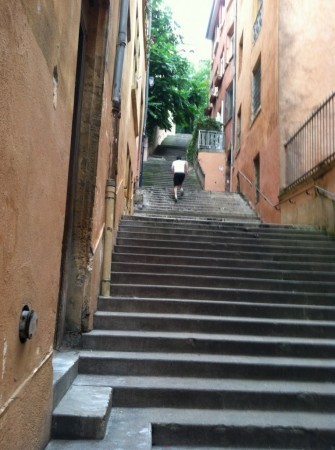 While he ran stairs, I went shopping.
While he ran stairs, I went shopping.
The post France, Part Deux appeared first on Sarah Albee.
July 20, 2014
Bonjour from Paris!
I’m in France for ten days with my history-teacher husband. On the itinerary are many places we’re both eager to see, including Lyon, some chateaux in the Loire Valley, the Bayeux tapestry, and the beaches and battle sites of Normandy. But Saturday was a special day for me. We visited the Paris sewers.
 Yes, there is actually a museum devoted to exploring the sewers beneath the streets, of which Parisians get to be very proud. If you’ve read my Poop book, you’ll know that London was the first major city to build massive sewers, thanks to Sir Joseph Bazalgette. But Paris followed suit just a few years later. In 1854, Eugene Belgrand was appointed to be head of the Parisian Water Board.
Yes, there is actually a museum devoted to exploring the sewers beneath the streets, of which Parisians get to be very proud. If you’ve read my Poop book, you’ll know that London was the first major city to build massive sewers, thanks to Sir Joseph Bazalgette. But Paris followed suit just a few years later. In 1854, Eugene Belgrand was appointed to be head of the Parisian Water Board.  His brilliant idea was to build aqueducts that supplied drinking water drawn from up river. His plan was completed in 1894, but not before Paris experienced serious cholera outbreaks as well as a major Big Stink, similar to the one in London in the 1850s. Interestingly, there’s no mention of the Paris Big Stink in the museum exhibit. But they have models of dredger wagons, which were used to move the euphemistically called “hybrid mixture” along and which then “irrigated and fertilized” fields downstream from the river. I’ve always felt sorry for those residents living downstream from these major urban engineering projects.
His brilliant idea was to build aqueducts that supplied drinking water drawn from up river. His plan was completed in 1894, but not before Paris experienced serious cholera outbreaks as well as a major Big Stink, similar to the one in London in the 1850s. Interestingly, there’s no mention of the Paris Big Stink in the museum exhibit. But they have models of dredger wagons, which were used to move the euphemistically called “hybrid mixture” along and which then “irrigated and fertilized” fields downstream from the river. I’ve always felt sorry for those residents living downstream from these major urban engineering projects.

I learned about the so-called “cleaner balls” that are used to clean the sewers. They’re these giant floating balls that are slightly smaller than the tunnel’s circumference—the waste water is pushed through it around the ball at high speed. Here’s a picture. (The French, I’ve found, like to put cheerful faces on a lot of their signage.)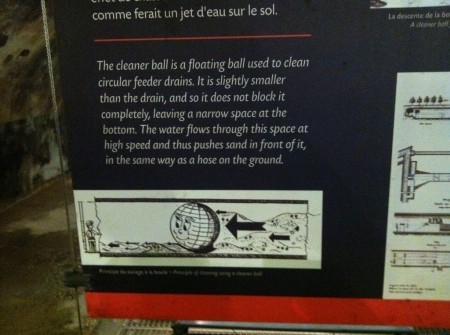

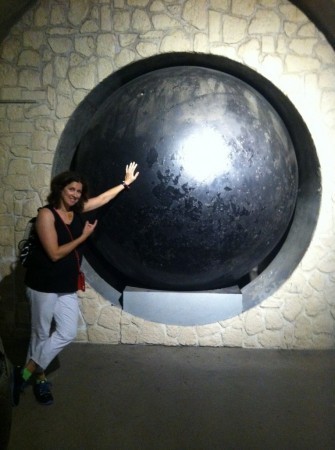
You can actually stand on grated flooring and watch the water whoosh by you as you make your way through the exhibit. Yes, it was a little sulphurous smelling down there, but I can’t begin to tell you how cool it was. Here’s a five-second video: IMG_2706My husband, I noticed, kept well away from the open grates. It was mostly me and the ten year old boys who ventured over them.
More than you want to know? All right, I’ll switch to open sewers channels in the streets.
We were walking through a lovely medieval district called Le Marais, which is also known as the Jewish quarter. I had to snap a picture of this narrow, cobbled street, which still has an open channel running through it the way it must have four hundred years ago.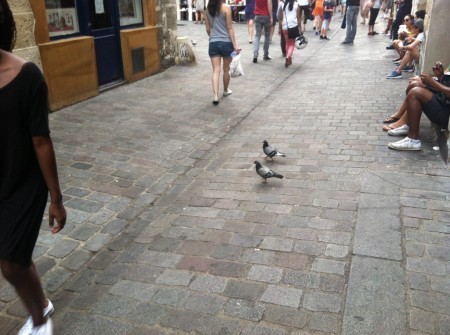
The post Bonjour from Paris! appeared first on Sarah Albee.
July 17, 2014
Triple Tragedy

Credit: The National Trust
On Monday I blogged about this portrait of Richard Croft’s children—where Herbert, aged ten, is lying in the pose of Melancholy, in the background in partial shadow, due to his having died.
The children’s father, the 6th Baronet Richard Croft, has his own tragic story.
Croft was a doctor from an aristocratic family, and in 1817 he became the personal physician overseeing the pregnancy of Princess Charlotte, second in line, after her father, to the British throne. At the time, doctors could do little to hasten the birth of a child during a difficult labor; labor-hastening drugs were not available, and, in this pre-anesthesia, pre-antibiotic world, Caesarean section almost always led to the death of the mother, from shock or sepsis. Obstetrical forceps were known, but Croft was part of a group of influential obstetricians who thought they should be used only as a last resort.

Princess Charlotte and Prince Leopold on their wedding day
The princess went into labor two weeks after her expected due date. After fifty hours of difficult labor, she finally delivered a nine pound baby boy, but he was stillborn. The princess lost more blood, began vomiting, and died five hours after delivery, probably from hemorrhagic shock. She was 21.
The nation was grief stricken. Had the princess survived, she would have become Queen of England upon the death of her unpopular father, George IV, and her grandfather, George III, whom the public perceived as mad.
Although a report issued two weeks later held Dr. Croft blameless for the beloved princess’s death, it’s likely that had he used forceps both the baby and the mother might have been saved.
Despondent about the deaths, Croft shot himself three months later.
After Charlotte’s death, there was a scramble to determine who would succeed the Prince Regent, who was 59 and had no more legitimate offspring. The brothers of the prince regent (Charlotte’s father), were ordered to dump their mistresses and find suitable wives. One of Charlotte’s uncles, Edward, the Duke of Kent, was hastily married off to the sister of Leopold (Charlotte’s widower). The line of succession would pass to Edward, and then to their child, who was born in 1819. She assumed the British throne in 1837, as Queen Victoria.
Sources: Pitkin, Whom the Gods Love Die Young: A Modern Medical Perspective on Illnesses that Caused the Early Death of Famous People 48-51
http://www.newyorker.com/archive/2006...
http://www.theguardian.com/culture/20...
The post Triple Tragedy appeared first on Sarah Albee.
July 14, 2014
Skeleton Suits

Manuel Osorio Manrique de Zuñiga (1784–1792), possibly 1790s Francisco de Goya y Lucientes (Spanish, 1746–1828)
I have a new book coming out next February with National Geographic. Here’s the cover. The subject is fashion, namely, a history of the world through the lens of what people wore, and why. It’s in the final layout phase now. The layout phase has been so much fun, because I love, love, love to do image research. The one downside of image research is that it’s so easy to get sidetracked.
Here’s one story I couldn’t resist sharing. I was researching late 18th century children’s wear and, specifically, looking for an image of a boy in a skeleton suit. During the Enlightenment, the Great Thinkers were urging a return to the natural state. In Rousseau’s famous essay on education (Emile ), he urged parents to de-hoop and de-corset their children (well, at least the boys). As he put it:
The limbs of the growing child should be free to move easily; there should be nothing tight, nothing fitting closely to the body, no belts of any kind . . .
After that, the skeleton suit—a loose-fitting, relatively unrestrictive garment, became all the rage. (Rousseau didn’t exactly practice what he preached, though, when it came to giving children an unrestricted upbringing. He fathered five children out of wedlock with his housekeeper, and sent every one to the foundling hospital. Nice, JJ.) For more on children’s wear and skeleton suits, see my blog post here.
Here’s the picture I found, painted around 1803 by John James Halls:

Credit: The National Trust
These are the children of one Richard Croft. (More about Richard on the next blog–his is a fascinating story.) There’s Thomas, in the red and gold sailor suit, blowing bubbles. Francis, aged five, is in the white dress, and the baby is named Archer. But the poignant one is Herbert, in black with a book. He would have been ten years old. The painter put him in the traditional pose of Melancholy, because Herbert is dead. He sat for the artist early on, but by the time the paining was finished, in 1803, he had died.
The post Skeleton Suits appeared first on Sarah Albee.
July 7, 2014
Authorizing
 Today is the first full day of my annual writing retreat, on the beautiful shores of Lake Champlain, near Plattsburgh, NY. I’m here with a couple of dozen other children’s book writers. We’ll be spending the next several days writing in solitude, in a beautiful setting, sharing meals together that someone else cooks. This blog will resume next week!
Today is the first full day of my annual writing retreat, on the beautiful shores of Lake Champlain, near Plattsburgh, NY. I’m here with a couple of dozen other children’s book writers. We’ll be spending the next several days writing in solitude, in a beautiful setting, sharing meals together that someone else cooks. This blog will resume next week!
The post Authorizing appeared first on Sarah Albee.
July 3, 2014
Curve Balls

Torsten Bolten, (http://creativecommons.via Wikimedia Commons)
We’re in World Cup Soccer Frenzy mode in my house, and sad as it was to see the U.S. lose to Belgium on Tuesday, it was an incredible game. I am married to a former goalkeeper and have spawned two goalkeepers and a midfielder, so even though I’m not super knowledgeable about the game, I have lots of people around me who can answer my questions.
For instance, there was that unbelievable goal by Jermaine Jones in the game against Portugal. In case you missed it, here’s a video. Sorry about the ad you have to slog through first.
Did you see how the ball curves around and then at the last instant bends in and down and lands in the net? It seems to defy the laws of physics. “That was crazy!” I yelled. “How did he even do that?”
Yes, I have a lot of people around me who can answer my questions, but real sports fans hate being bothered by people like me in the middle of a game. So no one answered me. “It was, like, right out of The Matrix!” I persisted. “How did he—how does that even happen?”
Finally my husband said, “Go ask Rusty.”
So I asked Rusty. He’s a friend of ours who happens to teach physics. And he told me that Jermaine’s kick was not in violation of the laws of physics. On the contrary, he said, it can be explained by something called the Magnus Effect.

Heinrich Gustav Magnus, German chemist and physicist.
The Magnus Effect was discovered by a guy named Gustav Magnus (1802 – 1870), who was investigating why cannonballs tended to swerve in their flight path. When an object spins through the air, various forces are acting on it, besides gravity, which everyone knows about. According to the Magnus Effect, you can predict a parabolic path according to the way the ball is spinning. If it’s going clockwise, there’s a force perpendicular to the spin axis (a top spin) that forces it down. If it’s spinning counterclockwise, the force pushes it up. A tennis player will hit a ball with topspin to get it to curve down. A golfer will strike a ball with backspin, so the force pushing it upwards tends to keep it in the air longer. A pitcher can make a ball curve around a vertical axis, which makes it curve off to the left or to the right (depending on the direction it’s spinning) causing it to swerve away from the batter.
Jermaine’s ball, from what I can tell by watching the video from different angles, seems to be rotating counterclockwise, but more or less on a vertical axis, which is why it acts like a curve ball. At the last instant, it swerves to the left and drops in.
Here’s a video Rusty sent me, which helps explain the physics.
The post Curve Balls appeared first on Sarah Albee.
June 30, 2014
It’s About Slime
According to this article (and many others), Chilean farmers noticed that after handling snails they were breeding for escargot, their hands felt noticeably smoother. The snail’s secretions protect its own skin from cuts and scrapes and UV rays.
And here I thought snails were only useful for food adulteration—snails were tossed into watered down milk in the 19th century to thicken it and add an attractive froth.
Snail slime facials are also a trend. You can watch a video here or see a charming picture here.
And while we’re on the subject: in this painting of the Holy Family by Baldassare Carrari (ca 1485), there are a number of religious symbols that might be lost upon a modern viewer, but here’s one you’ll know from now on. Look carefully at the lower right: you can see a snail trailing slime.  Here’s a close-up. Snail slime was meant to represent sin. What a long way snails have come in the way of positive PR.
Here’s a close-up. Snail slime was meant to represent sin. What a long way snails have come in the way of positive PR.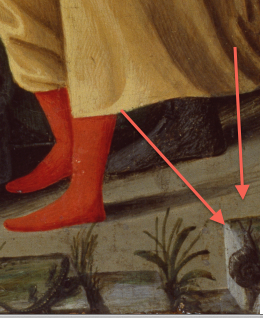
The post It’s About Slime appeared first on Sarah Albee.

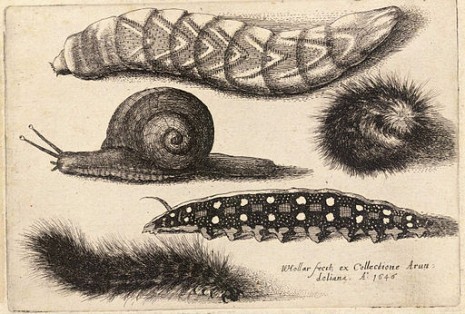 This is hardly breaking news—in fact, the Greek physician Hippocrates (460 – 370 BC) was the first to herald the benefits, but did you know that snail-slime face cream is a hot beauty trend? Creams containing slug mucus have been flying off the shelves in far-flung places like Korea and South America.
This is hardly breaking news—in fact, the Greek physician Hippocrates (460 – 370 BC) was the first to herald the benefits, but did you know that snail-slime face cream is a hot beauty trend? Creams containing slug mucus have been flying off the shelves in far-flung places like Korea and South America.

